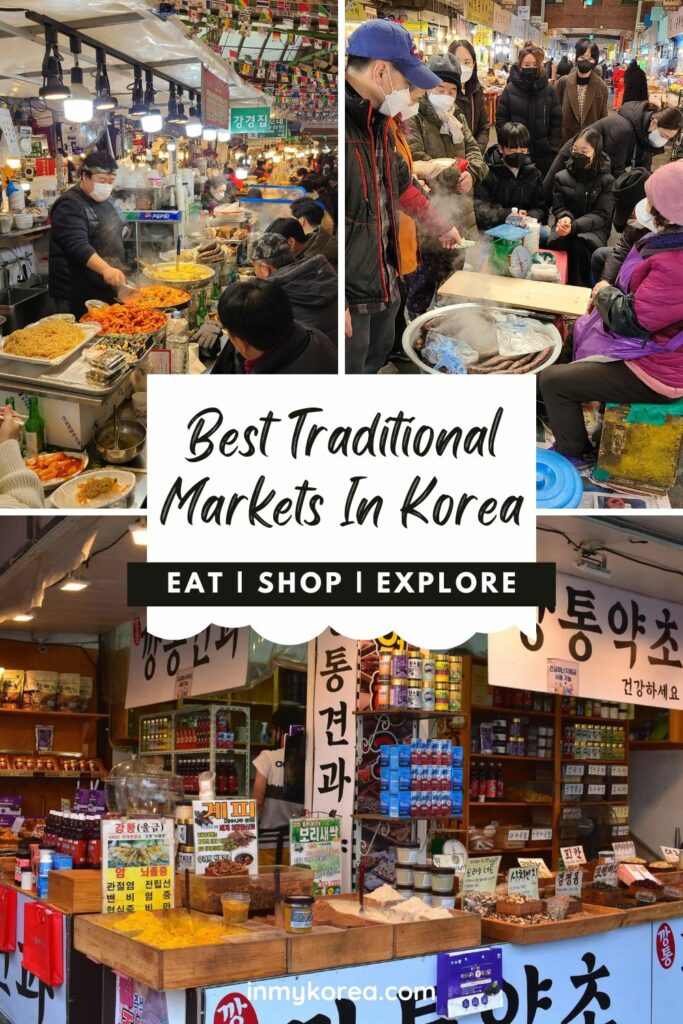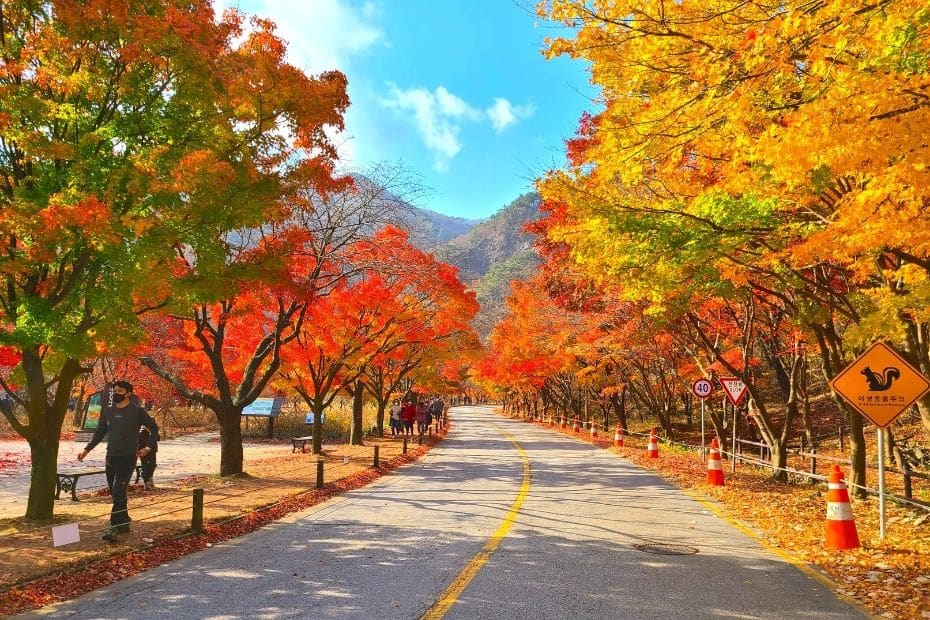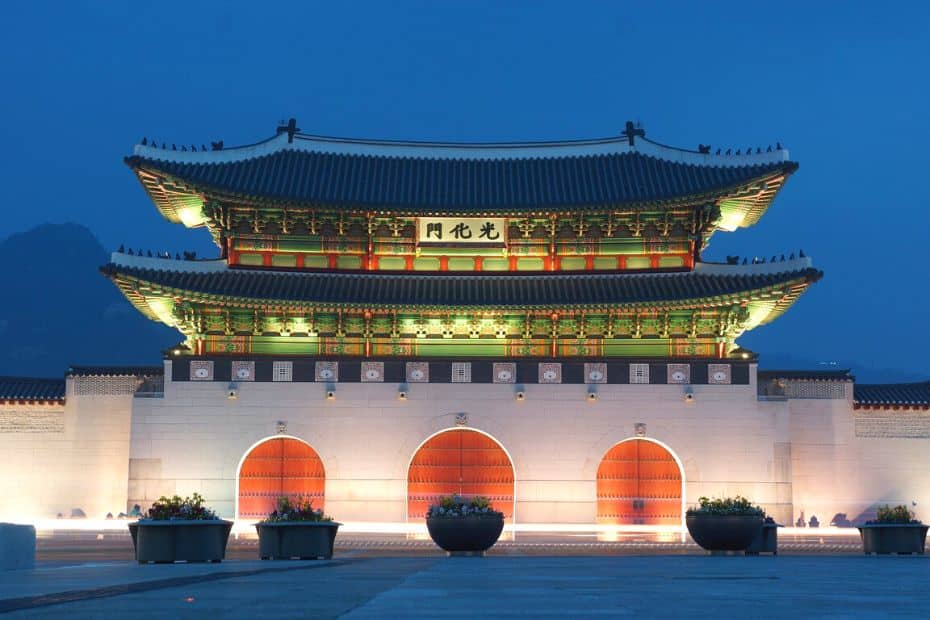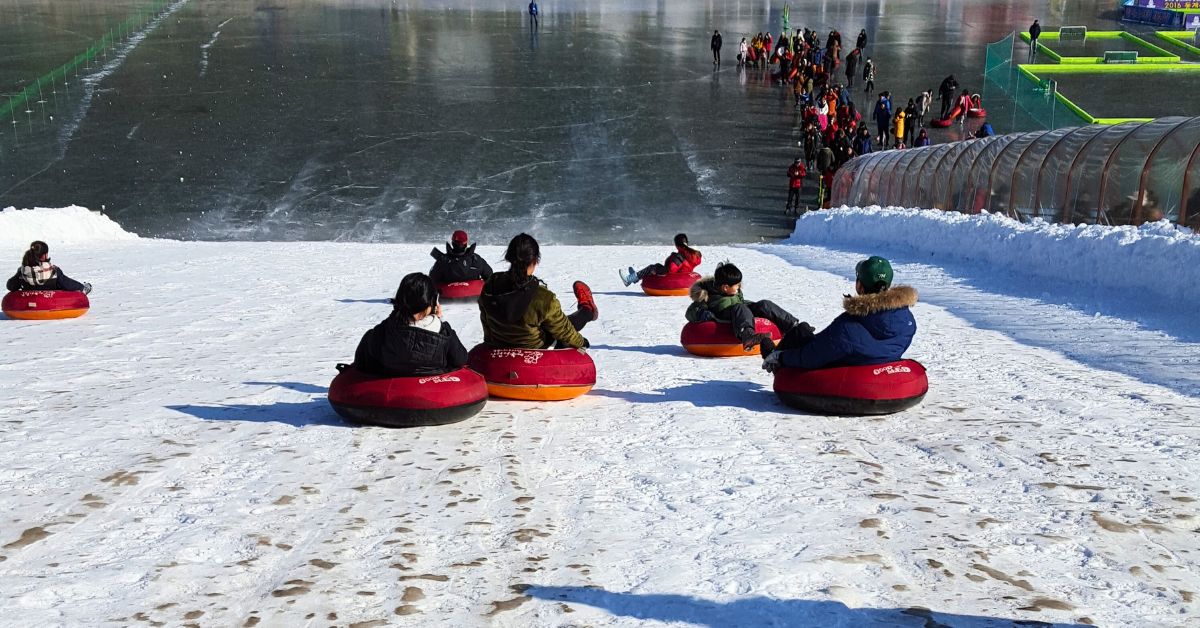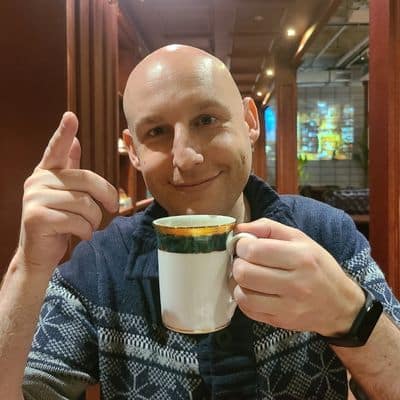No trip to Korea would be complete without a visit to a Korean traditional market, such as the massive Namdaemun Market in Seoul or the fresh fish displays of Jagalchi Market in Busan. Whether you want to shop for souvenirs, buy original Korean goods, or simply stuff your face with delicious Korean snacks, traditional markets in Korea have what you’re looking for.
Korea’s traditional markets have become must-see destinations thanks to the spread of Korean culture, food, and products across the world. You can buy cheap treats, stock up on Korean ginseng, bulk buy quality cosmetics, and relax with a bowl of something yummy in the surrounds of a bustling, active market. For a glimpse into the real life of a Korean city, you should definitely visit one of these markets.
The best thing about visiting a traditional market in Seoul or other cities is that you can find a wide variety of traditional and modern goods at lower prices than you’ll find in shops and department stores. If you’re a foodie, you can save a lot by eating out in places like Seoul’s Gwangjang Market and try incredible Korean dishes you’ve probably never even heard of but will fall in love with instantly.
Affiliate Disclaimer: This site contains affiliate links and I may earn commission for purchases made after clicking these links.
Top 10 Traditional Markets In Korea
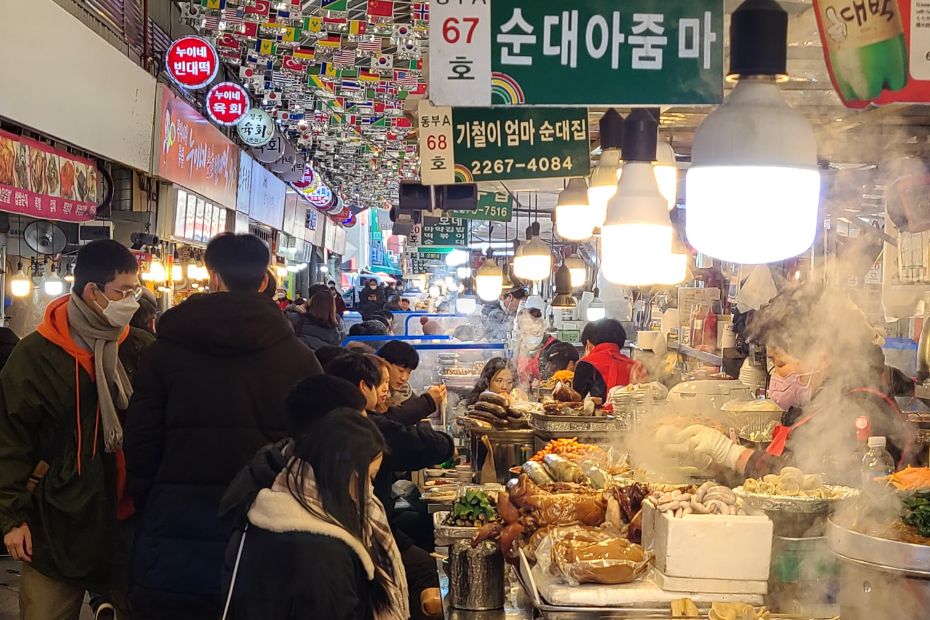
Korea is a modern and forward-looking country with high-tech products and transport improving every year. However, it’s also a country that values its connections to the past and maintains traditional areas where people can experience a way of life that has been around for generations. One such place which highlights Korea’s past mixing with its present is at a Korean traditional market.
Korea’s traditional markets are great if you live in Korea as you can find cheap fruit and veg as well as cheap eats for when you’re hungry. For tourists, they’re a window into Korea’s past and an opportunity to go bargain hunting, try traditional Korean foods, and stock up on souvenirs, Korean goods, cosmetics, and lots more. They’re also interesting places to walk through to experience real Korean culture.
Here are the top 10 traditional markets in Korea I think you should visit:
1: Namdaemun Market In Seoul
Why visit this market: Namdaemun Market (남대문시장) is the largest traditional market in Korea, with thousands of stores selling everything from fresh produce and Korean street food to handicrafts and traditional medicines. With over 600-years of history, this is the perfect place to experience real Korean market life and to buy authentic Korean goods or souvenirs to take home.
What to buy: This traditional market in Seoul has it all, from fashion to foods, fabrics, face masks, and more. There are many zones in the market catering to different needs. If you want to pick up some healthy Korean ginseng, Namdaemun Market is the best place to find it at a good price. Worried about taking your purchases home? There’s even a suitcase section in case you need extra luggage.
As this is a traditional market for Seoulites, not just tourists, you’ll find plenty of common household goods and traditional foods and medicines, but these tend to be in the downstairs areas in the market. Tourist-friendly goods are on the street level, including Korean clothes and accessories, souvenirs, and tasty treats. I recommend heading into the downstairs markets as you’ll see interesting sights.
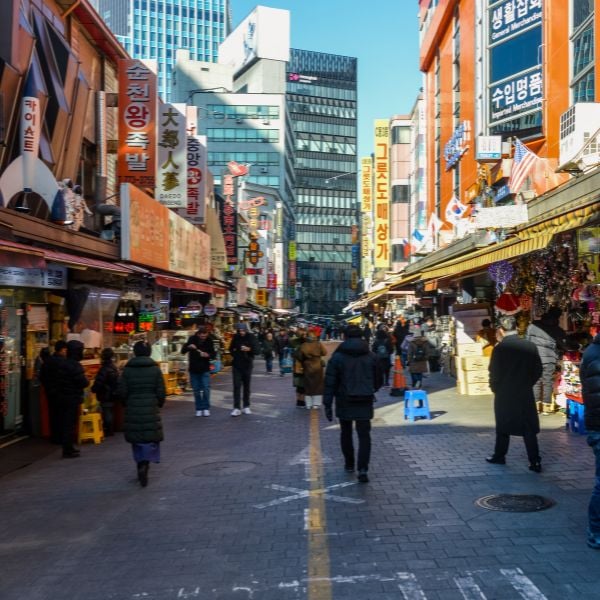
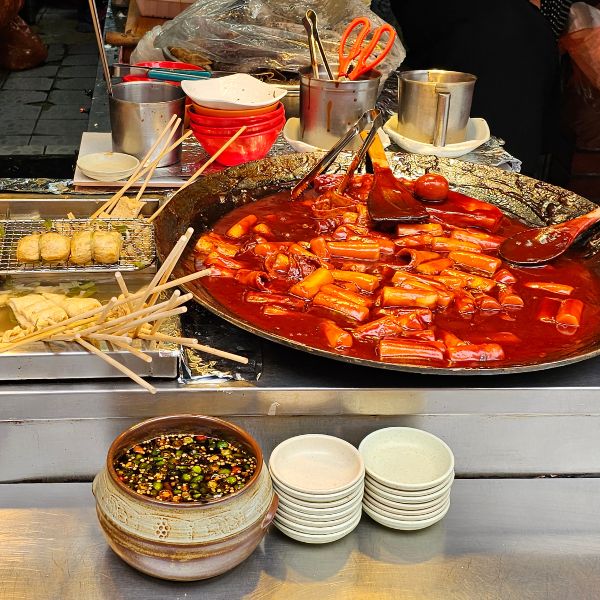
What to eat: Although nearby Myeongdong has some of Seoul’s best street food, you should definitely try the dishes available in Namdaemun Market. There’s all the street food favourites on offer, such as tteokbokki (spicy rice cakes), eomuk (fish cakes), hotteok (sweet pancakes), and kkochi (skewers).
Make sure you try traditional Korean dishes such as kalguksu (칼국수), a hearty bowl of knife-cut noodles and one of my favourite traditional Korean dishes. You can also find galchi jorim (갈치조림) for sale in Namdaemun Market, which is a spicy braised cutlassfish stew.
Tip for this market: Haggling is accepted but expect the market vendors to drive a hard bargain. Take your time to shop around for the best prices and try not to accept the first price offered.
Address:
서울 중구 남대문시장
Nearest Subway:
Hoehyeon Station
Opening Hours:
9:00am to 5:30pm
Closed:
Every Sunday
Planning to visit Korea? These travel essentials will help you plan your trip, get the best deals, and save you time and money before and during your Korean adventure.
Visas & K-ETA: Some travellers to Korea need a Tourist Visa, but most can travel with a Korean Electronic Travel Authorisation (K-ETA). Currently 22 Countries don’t need either one.
How To Stay Connected: Pre-order a Korean Sim Card or a WiFi Router to collect on-arrival at Incheon Airport (desks open 24-hours). Alternatively, download a Korean eSIM for you travels.
Where To Stay: For Seoul, I recommend Myeongdong (convenient), Hongdae (cool culture) or Gangnam (shopping). For Busan, Haeundae (Beach) or Seomyeon (Downtown).
Incheon Airport To Seoul: Take the Airport Express (AREX) to Seoul Station or a Limo Bus across Seoul. Book an Incheon Airport Private Transfer and relax to or from the airport.
Korean Tour Operators: Tour companies that have a big presence in Korea include Klook, Trazy, Viator, and Get Your Guide. These sites offer discounted entry tickets for top attractions.
Seoul City Passes: Visit Seoul’s top attractions for free with a Discover Seoul Pass or Go City Seoul Pass. These passes are great for families and couples visiting Seoul – you can save lots.
How To Get Around: For public transport, grab a T-Money Card. Save money on Korea’s high speed trains with a Korea Rail Pass. To see more of Korea, there are many rental car options from Klook, EconomyBookings, and RentalCars.
Travel Money: Use money exchanges near Myeongdong and Hongdae subway stations for the best exchange rates. Order a Wise Card or WOWPASS to pay by card across Korea.
Flights To Korea: I use flight comparison sites such as Expedia and Skyscanner to find the best flights to Korea from any country. Air Asia is a good option for budget flights from Asia.
Travel Insurance: It is important to insure your trips to protect yourself against the unexpected. World Nomad is a specialized travel insurance provider with options for different coverage for travellers from around the world. You can also purchase cover when you are already travelling.
How To Learn Korean: The language course from 90 Day Korean or Korean Class 101 both have well-structured lessons and lots of useful resources to help you learn Korean.
2: Gwangjang Market In Seoul
Why visit this market: Gwangjang Market (광장시장) is one of the most famous traditional markets in Seoul thanks to the Netflix show, ‘Street Food Asia‘, although it was popular long before then. This is the oldest permanent market in Korea, established in 1905, and one of the largest with over 5,000 stalls above and below ground. The best part about this market is definitely the food.
What to buy: Gwangjang Market is the place to go in Seoul if you want to buy your own hanbok, Korea’s traditional clothing that you’ll see people wearing around the royal palaces in Seoul. There’s a wide selection of hanbok shops where you can get your own custom-made hanbok prepared for you to take home or sent to you by post. There are many traditional Korean clothes and crafts here.

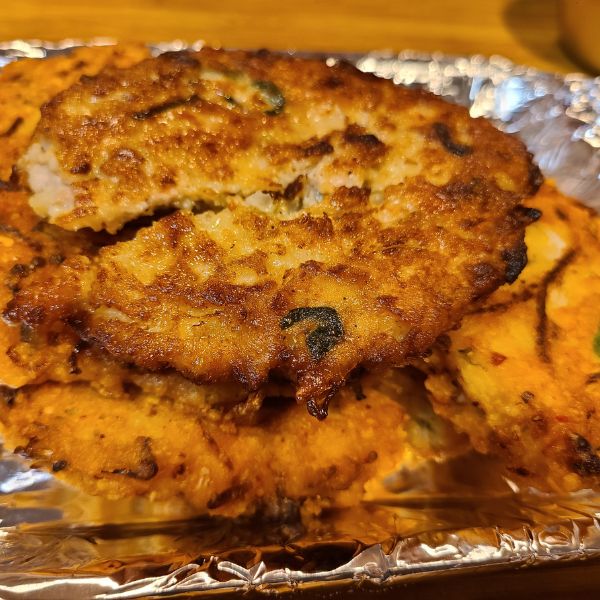
What to eat: Without a doubt, Gwangjang Market is the number one place to go in Seoul if you want to experience eating Korean food at a traditional market. You’ll find dozens of vendors selling all sorts of foods, including sundae (blood sausage), bibimbap (mixed rice with veg), gimbap (rice roll), and mandu (dumplings). Just grab a seat and point to whatever you want to eat.
If you want a cosy dining experience, I recommend squeezing into one of the narrow restaurants opposite the main food stalls and ordering a plate of bindaetteok 빈대떡 (mung bean pancake) with a bowl of makgeolli 막걸리 (rice wine). The tables are squashed together and usually packed, you might be sharing a table with others, but the food and wine is so good you won’t even notice.
Tips for visiting this market: Sit down and get a meal of bindaetteok and makgeolli in the small restaurants around the centre of the market. Order the mixed pancake set to try the various flavours and get a bottle of makgeolli to wash it down. It’s a great combo.
Address:
서울 종로구 창경궁로 88
Nearest Subway:
Jongno 5 Station
Opening Hours:
9:00am to 6:00pm (Food area until 11:00pm)
Closed:
Every Sunday
3: Seoul Folk Flea Market In Seoul
Why visit this market: The Seoul Folk Flea Market (서울 풍물시장) is not your average Korean traditional market. This unique space is dedicated to folk items from across Korea and retro items you won’t find elsewhere. Modernised in 2008, this market was originally a collection of stalls by the Cheonggyecheon Stream, but is now housed in a new building with restaurants, goods, and more inside.
What to buy: The Seoul Folk Flea Market is like a labyrinth, with long aisles packed full of interesting and unique goods to pick up and wonder at. You’ll find retro and vintage goods (1F) along with more modern market goods (2F), souvenirs, traditional goods, and traditional foods.
Unlike other traditional markets in Korea, you can find real history inside that you can take home and show your friends. There’s also a load of junk, but one person’s junk is another person’s treasure. The Seoul Folk Flea Market has 7 different coloured zones to help you find what you’re looking for. They are:
- Red Zone – Food Court
- Orange Zone – Regional Specialties (e.g. traditional crafts and foods)
- Yellow Zone – Vintage Goods (e.g old telephones and record players)
- Green Zone – Antiques (e.g. furniture and art)
- Blue Zone – Fashion Accessories
- Indigo Zone – Clothing & Art (e.g calligraphy and traditional Korean arts)
- Violet Zone – Misc. Goods (e.g electronics, tools, etc.)
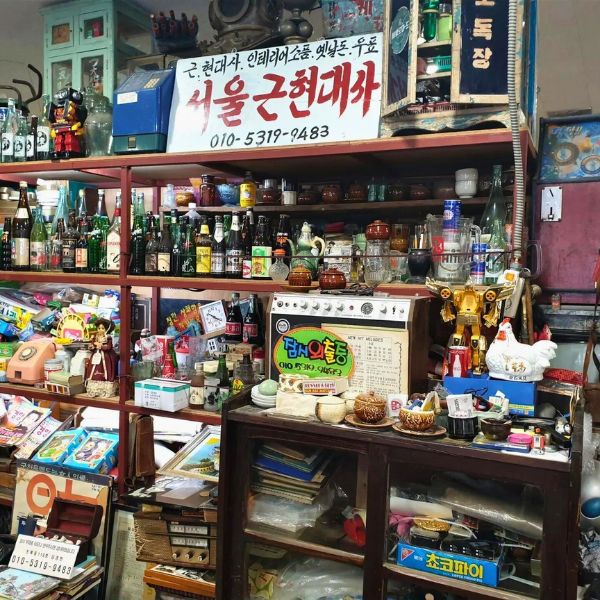
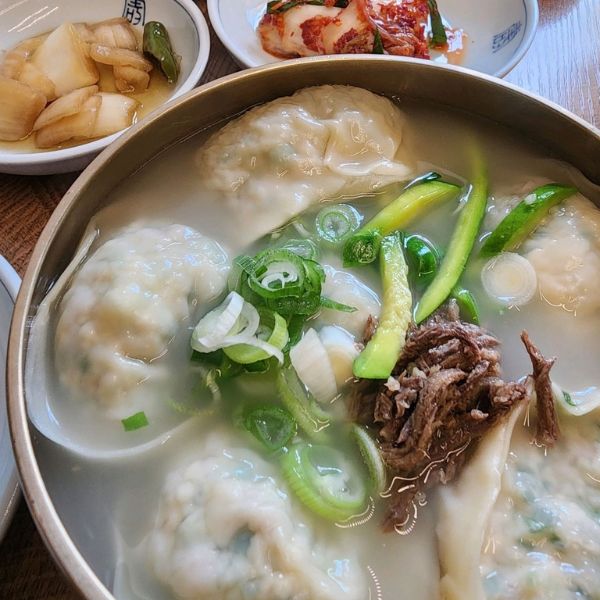
What to eat: There are plenty of traditional Korean dishes available at all traditional markets in Korea, and the Seoul Folk Flea Market is no exception. Try a big bowl of mandu guk (dumpling soup), kalguksu, or juk (porridge) to warm you up on a cold day. They’re good any time of year though, so don’t pass up the chance to have a cheap and delicious traditional meal here.
Tips for visiting this market: There really is something for everyone, even those who are just looking to take a snapshot of Korean history. Go for the retro and vintage items, sample some delicious traditional foods, and maybe find a rare treasure to take home with you.
Address:
서울 동대문구 천호대로4길 21 서울풍물시장
Nearest Subway:
Sinseol-dong Station
Opening Hours:
10:00am to 7:00pm
Closed:
Every Tuesday
4: Noryangjin Fish Market In Seoul
Why visit this market: Noryangjin Fish Market (노량진수산물도매시장) is a working fish market and a great place to sample some of Korea’s best seafood, freshly caught and sold that day. Operating since 1927 near Seoul Station, but later moved to more modern facilities next to Noryangjin Station, this market provides 50% of Seoul’s seafood.
What to see: Opening from 1:30am, early birds can discover the hidden world of Seoul’s fish markets, including the early morning deliveries and sorting. The best time to visit is from 3:00am when the live fish auctions happen each day. These are a spectacle in themselves and you might be able to pick out what you want to eat for breakfast.
Wander down long aisles alive (literally) with fresh squid, octopus, shellfish, urchins, and all other kinds of seafood. You’ll be astounded by all the weird and wonderful sights that you probably didn’t know existed under the sea. I was certainly shocked the first time I visited a traditional Korean fish market.
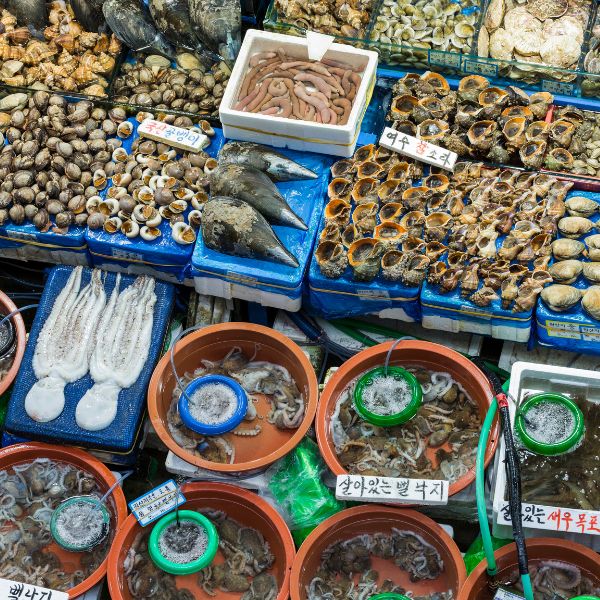
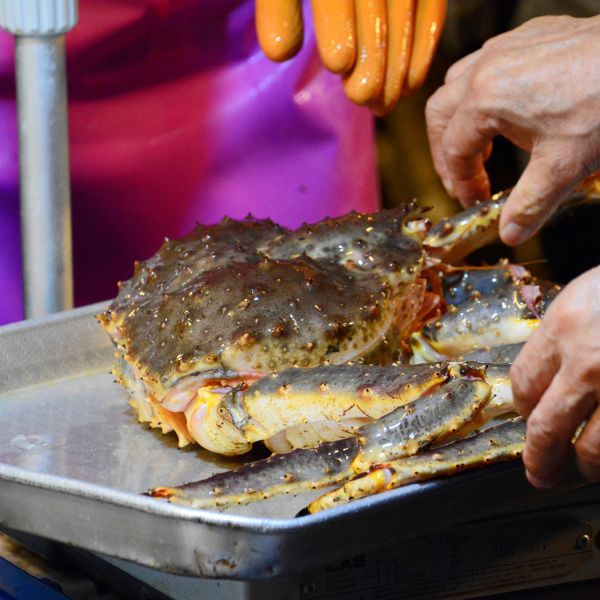
What to eat: The seafood sold at the fish auctions at Noryangjin will find their way into various dishes, such as jjukkumi 쭈꾸미 (baby octopus), maeuntang 매운탕 (spicy fish broth), and haemul pajeon 해물 파전 (seafood and green onion pancake). There’s also crab, lobster, and hoe 회 (fresh raw fish) prepared in the market for your breakfast. A great start to the day and very healthy.
Tips for visiting this market: This bustling, stinky, wet, fresh market will provide a wonderfully unique experience during a stay in Seoul but getting there for the fish auctions can be hard. I recommend staying somewhere close, such as Hongdae, and then taking a taxi to the market in the morning.
Address:
서울 동작구 노들로 674 노량진수산물도매시장
Nearest Subway:
Noryangjin Station
Opening Hours:
1:30am to 10:00pm (public access)
Closed:
Doesn’t close
5: Tongin Market In Seoul
Why visit this market: Seoul’s traditional markets have great food and Tongin Market (통인시장) is no exception, but the food here is served in a different way from the other markets. At Tongin Market you can buy a lunch box, or doshirak in Korean, to fill up with your favourite snacks from select vendors throughout the market. A lunch box costs ₩5,000 and is a great way to sample Seoul’s street food.
Tongin Market, which started in 1941, is famous for these lunch boxes as the area was previously home to Japanese residents who were used to buying bento boxes (Japanese lunch boxes). Decades later, the market is home to many restaurants and shops, dozens of them participating in the unique lunch box program. There are also market goods available to buy between the stalls.
What to buy: One of the main draws of this market is the lunch box program, which runs every day except Monday. Pay the cost of the lunch box and you’ll receive a plastic lunch box and a collection of gold coins to use to pay for foods throughout the market. Each item costs a number of coins and you can buy foods from participating stalls with signs saying “gamaengjom” (가맹점).
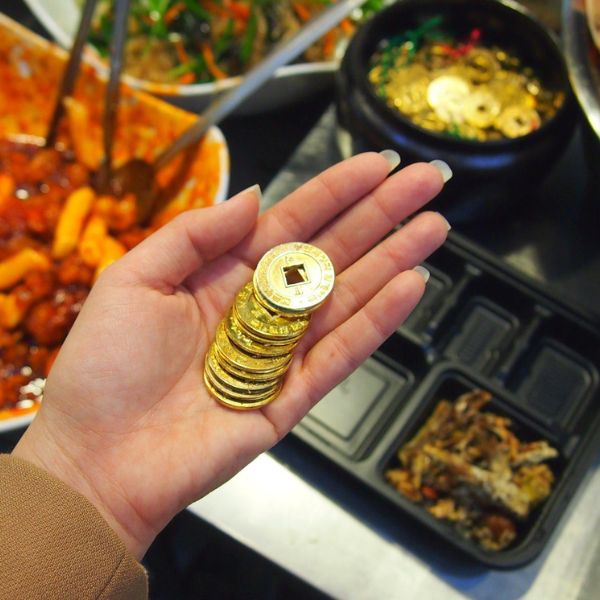
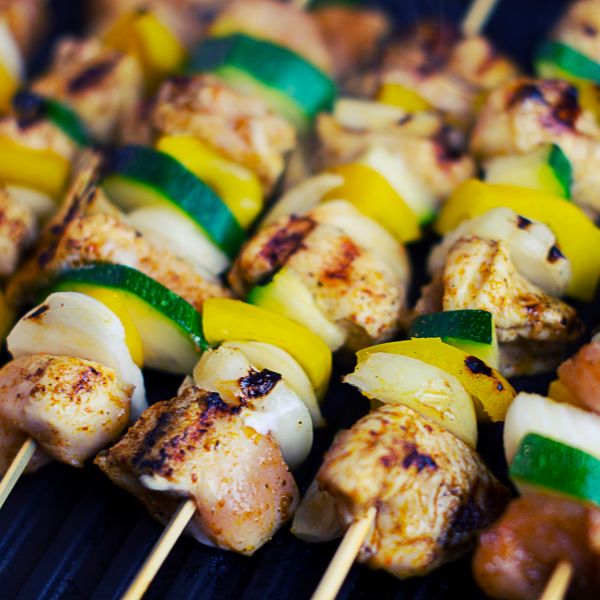
What to eat: With over 70 stalls to choose from, each selling a wide range of delicious Korean street food snacks or meals, there’s something for everyone. I recommend trying some mandu 만두 (dumplings), tteokbokki 떡볶이 (spicy stir-fried rice cakes), and flame cooked dakkochi 닭꼬치 (chicken skewers). After you’ve made your purchases, take a seat on the benches in the market.
Tips for visiting this market: This market is west of Gyeongbokgung Palace, but often overlooked as people head to Bukchon Hanok Village and other sights east of the palace. It’s not the first traditional market in Seoul you should see, but if you have enough time, add Tongin Market to your itinerary as well as the nearby Cheong Wa Dae (President’s Blue House).
Address:
서울 종로구 자하문로15길 18
Nearest Subway:
Gyeongbokgung Station
Opening Hours:
11:00am to 4:00pm (Lunch box service)
Closed:
Third Sunday of each month
6: Nambu Traditional Market In Jeonju
Why visit this market: There’s more to Jeonju than the historic Jeonju Hanok Village, which you can see on a day trip from Seoul, including Jeonju’s lively traditional market – Nambu Market (전주 남부시장). Nambu Market has existed for over 100 years, however, it wasn’t until 2011, and the addition of the Youth Mall, that Nambu Market really became a hot spot in the centre of Jeonju.
Other special features of this market are the weekly night markets, held on Friday and Saturday nights from 7:00pm to 11:00pm in winter (12:00am in summer). You’ll find many street food stalls and vendors catering to people who want to enjoy a night out in the town. It’s similar to Myeongdong’s night markets, but you can also see live performances and cultural shows around the market.
What to buy: You can find a range of typical goods for sale that you’d find in Seoul’s traditional markets, such as snacks, local produce, food, accessories, home goods, and lots more. However, for tourists, the Youth Mall section might offer more interesting shops and sights, including locally made handicrafts, souvenirs, and interesting knick-knacks that Koreans love to collect and display.
The Youth Mall is run by local young entrepreneurs and is housed in the previously abandoned second floor of the market. It adds youthful charm, design, and culture to this historic area and is now often compared with the likes of Hongdae in Seoul. You can find some great food, clothes, and creative goods in the Youth Market, as well as artistic displays on the walls and in shops.
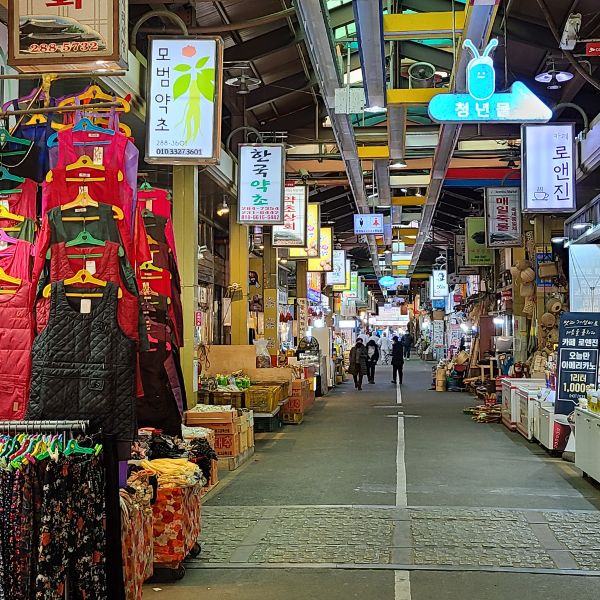
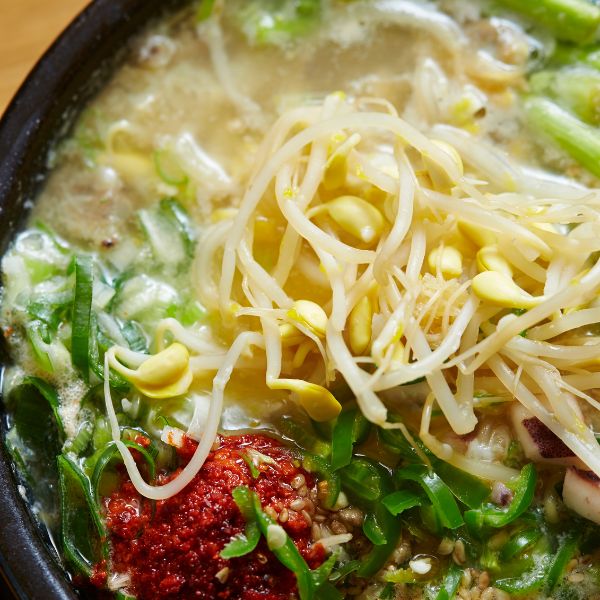
What to eat: Jeonju is known as the food capital of Korea, just like Osaka is in Japan There are many wonderful foods you can try at this traditional market, such as sundae gukbap 순대국밥 (blood sausage soup with rice), kongnamul gukbap 콩나물 국밥 (bean sprout soup with rice) and pat kalguksu 팥칼국수 (red bean noodle soup). Check out the Youth Mall for more modern dining options and bars.
Tips for visiting this market: As Jeonju is home to Jeonju bibimbap 비빔밥 (mixed rice with vegetables), you certainly shouldn’t waste the chance to try one of Korea’s most famous traditional foods in the city that does it best.
Address:
전북 전주시 완산구 풍남문1길 19-3 남부시장상인
How To Get There:
Take an intercity bus from Dong-Seoul Bus Terminal
Opening Hours:
9:30pm to 10:00pm every day
Closed:
None (but maybe holidays)
7: Jagalchi Market In Busan
Why visit this market: Jagalchi Market (자갈치시장) is one of several traditional markets in the downtown Nampo area of Busan and one that will make you feel like the sea has come to you. This is Busan’s main fish market (and Korea’s biggest) and the best place to try fresh Korean seafood. Like Noryangjin Market in Seoul, you’ll find a wide selection of the sea’s harvest for sale here.
What to buy: The main thing for sale at this traditional market is of course seafood in all shapes and sizes. There’s everything from shrimp to squid, octopus to oysters, and all else that hangs around under the sea. You’ll find Korea’s seafood delicacies for sale in the market, as well as outside the market in the many seafood restaurants selling Busan’s best local dishes, such as octopus tentacles.
You can buy freshly sliced fish, usually served as thin slices to be dipped in soy sauce like Japanese sashimi, or you can buy seafood to take home and prepare there. If you don’t want to take it home, then you can get it prepared and served in one of the market’s restaurant instead. Or you could just visit one of the many seafood restaurants nearby and see what they have to offer.
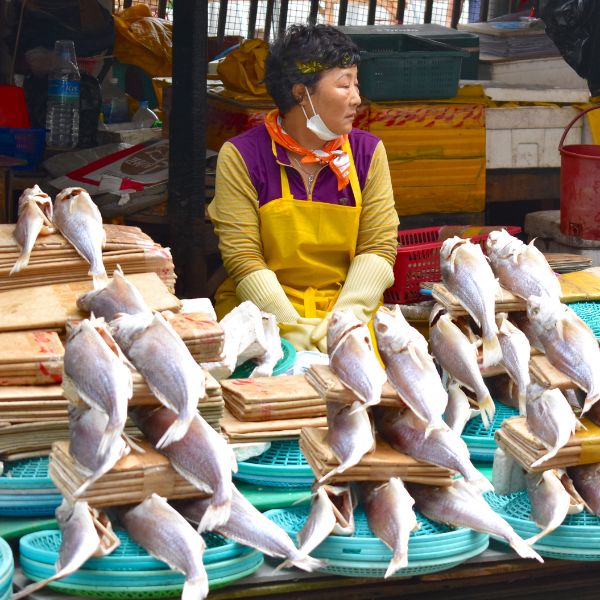
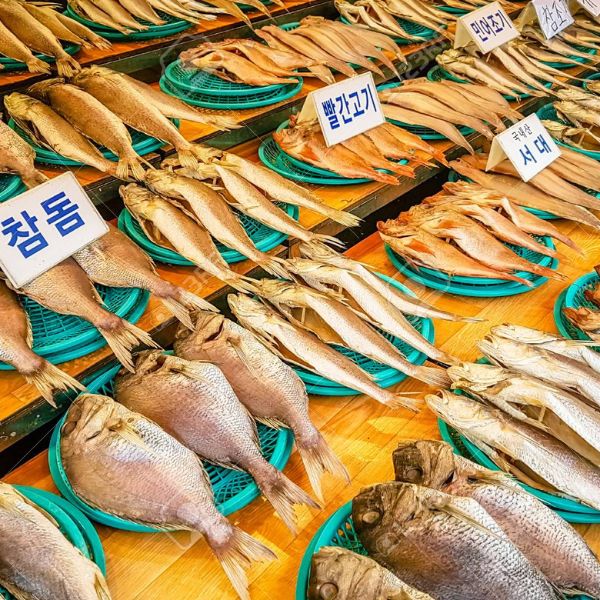
What to eat: If you have the courage, why not try some nakji 낙지 (octopus tentacles) or even sannakji 산낙지 (raw / live octopus tentacles)? For those who are less brave, consider some maeuntang 매운탕 (spicy fish soup). You won’t find a shortage of places selling these nearby. Popular seafood offerings are mackerels, sea squirt, and lobster. There’s a seafood buffet if you’re really hungry, too.
Tips for visiting this market: For those who don’t much enjoy the taste of seafood (I understand you!), there are plenty of other markets and restaurants nearby. However, I’d still recommend checking out this sprawling market just for the unique sights, sounds, and, most overwhelmingly, the smells.
Address:
부산 중구 자갈치해안로 52 자갈치시장
Nearest Subway:
Jagalchi Station
Opening Hours:
5:00am to 10:00pm
Closed:
Tuesdays
8: Gukje Market In Busan
Why visit this market: Situated in the same part of Busan as Jagalchi Market, Gukje Market (국제시장) offers visitors a more traditional Korean market experience with an international twist. This market is located close to many other popular sights in Busan, such as Bosu-dong Book Alley, BIFF Square, Busan Tower, and Gwangbok-ro Fashion Street, so you can see lots from here.
This is Busan’s largest traditional market and despite the typical sights like stalls full of Korean herbs and spices, clothes, and Korean dishes, you can also find a lot of international goods here. Gukje Market was established in the 1950s by Korean war refugees and has benefited from Busan’s status as a port city, which see many international sailors, travellers, and expats visiting the market.
What to buy: This market has a wide range of traditional Korean goods, such as foods, snacks, handicrafts, medicines, and everyday stuff Korean people need. There are many small boutique stalls squeezed in among the traditional goods where you can find interesting souvenirs, books, stationery, gifts, accessories, and sweet treats, Be sure to pick some up to take home with you.

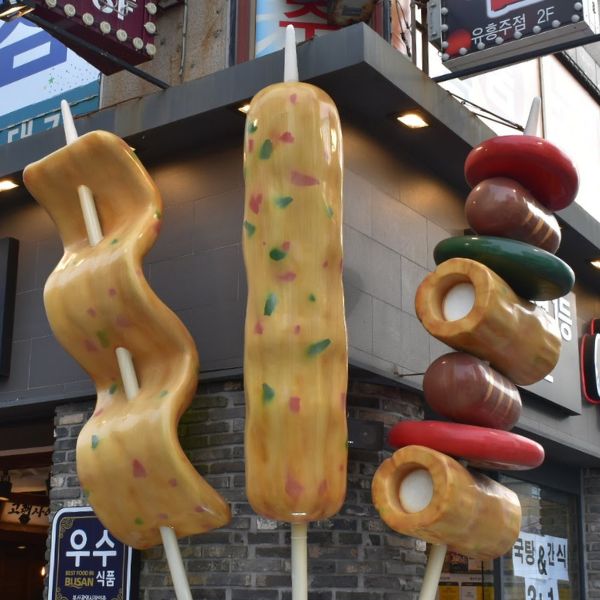
What to eat: You can’t shop in Gukje Market without sampling some unique market foods! Gukje Market has some of Busan’s finest local dishes, such as bibim dangmyeon 비빔당면 (spicy glass noodles), yubu jeongol 유부 전골 (fried tofu stew), and ssiat hotteok 씨앗호떡 (seed-stuffed sweet pancake). This area is famous for eomuk (fish cakes), be sure to try those from the street food stalls, too.
Tips for visiting this market: Mix up a day exploring this historic area of Busan with a trip to the nearby Huinnyeoul Culture Village, Jeoryeong Coastal Walk, and an afternoon staring out at the sea from the Taejongdae Resort Park. Or visit those places first to avoid walking with shopping bags.
Address:
부산 중구 신창동4가
Nearest Subway:
Jagalchi Station
Opening Hours:
9:00am to 8:00pm
Closed:
Sundays
9: Seogwipo Maeil Olle Market On Jeju Island
Why visit this market: If you make your way down to Jeju, then you really should check out Seogwipo Maeil Olle Market (서귀포매일 올레시장) in Jeju’s second largest city, Seogwipo. This market caters to Korean tourists more than international tourists, as well as locals, and you can find some of Jeju Island’s incredible delicacies here, including the large hallabong orange (and other citrus) during winter.
This market feels less touristy and isn’t as crowded as the markets in Seoul and Busan. If you want to take your time to stroll through the shops, buy some cute Jeju souvenirs, taste fresh seafood, citrus, and other local delights, then Seogwipo Maeil Olle Market is the place for you. I love to stock up on foods from the market before travelling out of Seogwipo to hike or see the beaches of Jeju.
What to buy: Jeju Island is easily Korea’s most beautiful destination for nature lovers and thanks to the volcanic eruptions from Hallasan Mountain, it’s a place that’s very fertile and grows many delicious crops. Therefore, you should definitely pick up some fresh fruit while you’re at the market, such as hallabong orange, kiwis, avocados, passion fruit and even tropical dragon fruit.
Besides the fruits of the land, you’ll find many fruits of the sea for sale at Seogwipo Market, including freshly sliced raw fish, juicy shrimp, sea squirts, and octopus. For tourists, you’ll find the traditional markets are the best place to get great souvenirs of Jeju Island, such as chocolates with unique Jeju flavours (cactus, tangerine, green tea), local cosmetics, and the best green tea in Korea.
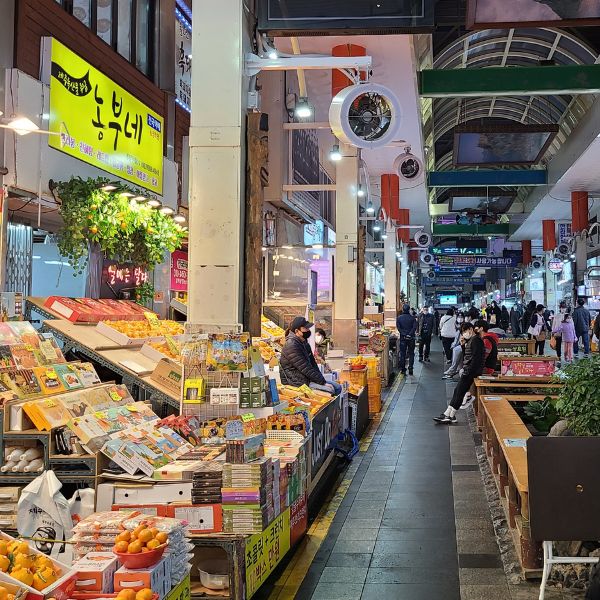
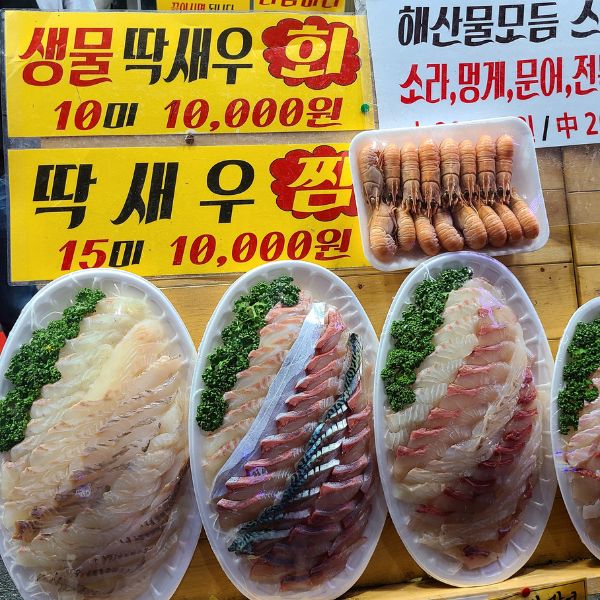
What to eat: If you want to try authentic Jeju Island street food, then buy a bag of dol hareubang manju 돌 하르방 만쥬 (small pastries shaped like the Jeju stone statues). Also known as Jeju Grandpas, these little cakes are delicious snacks filled with Jeju Island’s own hallabong 한라봉 (sweet tangerine). You’ll find stalls selling fresh hallabong juice with the bottle shaped like the iconic stone statues, too.
If you want something more filling, you can buy freshly caught fish and seafood that’s ready to eat. This is perfect if you want to have a quiet meal in your hotel or sitting down by the harbour watching the boats. There are other Jeju Island snacks here, too, such as black pork (흑돼지) buns and egg-wrapped gimbap, and the usual market foods like fried chicken, tteokbokki, and skewers.
Tips for visiting this market: There’s a really nice bar near the market called Jeju Beer Fountain (제주약수터) which sells locally brewed beers, including some very interesting tastes made with local products like a Jeju tangerine raddler. These beers are only available as takeout, which makes them perfect for drinking in your hotel room with some freshly sliced fish from the market.
Address:
제주 서귀포시 서귀동 340
How To Get There:
Walk from the Seogwipo Bus Terminal
Opening Hours:
7:00am to 9:00pm (8:00pm in winter)
Closed:
None (but maybe holidays)
10: Seomun Market In Daegu
Why visit this market: Last, but not least on this list of traditional markets in Korea is Seomun Market (서문시장) in Daegu. Steeped in history, this market has its roots as one of the three main markets during the Joseon Dynasty that ruled Korea for more than 500 years. These days, the market is as popular as ever and draws big crowds on the weekends for the Seomun Night Market.
Thanks to Seomun Market’s central location, you can explore the other sights of Daegu. such as to the Daegu Gyesan Catholic Church and the Missionary Houses to learn about Daegu’s tragic past. There’s also a tourist street through the city to the Hyangchong Cultural Centre, all about Korea’s recent history. This place is great for dressing up in classic Korean clothes of the early 20th Century.
What to buy: Seomun Market specialises in fabrics, including silk, satin, knitted goods, accessories, and clothes. However, you’ll also find a lot more to buy, such as fresh foods, jewellery, watches, and dried seafood. At Seomun Night Market, which opens until 11:30pm, you’ll find start-up shops for young designers, fusion food with unique takes on Korean food, and live music on certain nights.
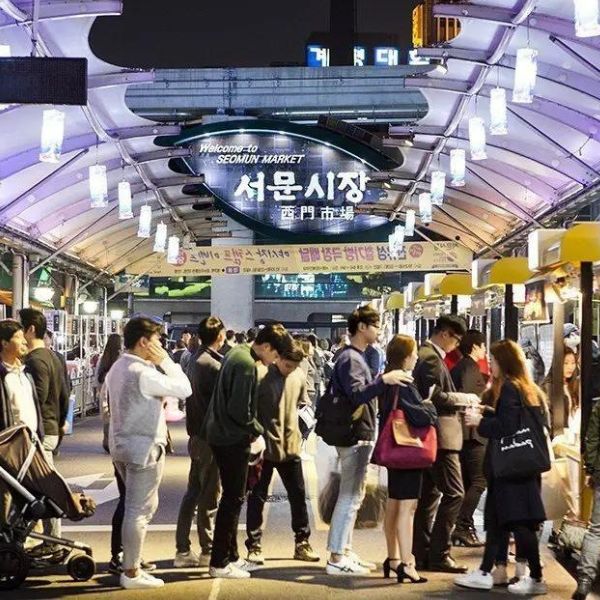

What to eat: If you want a traditional food experience, you’ll love the sujebi 수제비 (hand-pulled dough soup) that is made right in front of you. There are also freshly cut bowls of kalguksu, mandu 만두 (dumplings) and a popular dish across Korea, the ubiquitous eomug guk 어묵국 (fish cake soup).
Tips for visiting this market: You can see many of Daegu’s central sights in one day and Seomun Market is the perfect place to start your adventure. Take a bus (#425 / #651) from Dong Daegu Station directly to the market and then walk back through the city’s historic areas on the way back to the station. There are several walking paths through the city and they’re well signposted.
Address:
대구 중구 달성로 50 서문시장
Nearest Subway:
Seomunsijang Station
Opening Hours:
9:00am to 6:00pm (11:30pm Friday & Saturday)
Closed:
1st and 3rd Sunday each month
Why Myeongdong Market Isn’t On This List
When people talk about traditional markets in Seoul they might think of Myeongdong Market, which is famous for its delicious street food, cheap accessory and fashion stalls, and shops selling Korean cosmetics like face masks. However, this isn’t really what a Korean traditional market is about and Myeongdong is really more of an outdoor market to cater to the tourists flocking to this area.
Even though Myeongdong Market doesn’t make it on my list of the best traditional markets in Seoul, it’s still a must-see place in Seoul for the hustle and bustle of the night markets, the food vendors, and the busy streets. If you want to stay in Seoul, booking a hotel in Myeongdong is a great option as it’s close to all the action of Myeongdong, as well as traditional markets like Namdaemun Market.
What’s The Best Traditional Market In Seoul?
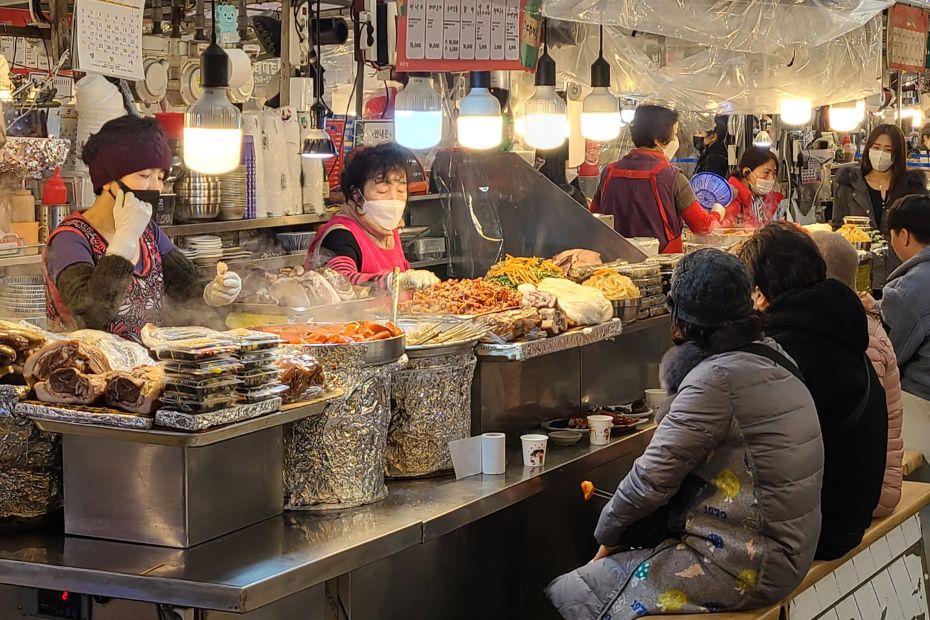
If I had to choose just one traditional market in Seoul to recommend to travellers, I would probably choose Gwangjang Market for the simple fact that it has an incredible selection of street food and small restaurants to dine in. Seoul has many traditional markets besides the ones previously mentioned in this article, and they all offer an interesting look into local culture and products.
Namdaemun Market is slightly bigger and perhaps has a wider selection of goods available, but it’s also quite spread out with many small streets to explore and feels like you’re in a maze at times. In comparison, Gwangjang Market feels more compact, with a central area selling lots of different dishes and small streets leading off from there. It’s easier to explore and see everything without getting lost.
The best traditional market in Seoul changes for each person. If you’re a vintage lover, you’re sure to love Seoul Folk Flea Market’s retro goods. If you want fashion bargains and accessories, Namdaemun Market and Dongdaemun’s markets and malls will leave you broke and with full bags of fashionable goods. There are also loads of smaller traditional markets throughout the city to discover.
Tours To Korea’s Traditional Markets
Not sure what to do at one of Korea’s traditional markets, what you should try, or need help finding the best things to eat and buy? Then why not book a tour to one of Korea’s traditional markets in Seoul or Busan and enjoy the experience without the worries. Here are a few market tours you might enjoy:
Seoul: Gwangjang Market Unique Food Tour: Experience Korean cuisine at Gwangjang Market, a historic and lively traditional market in Seoul. As one of Seoul’s top traditional markets, this tour offers a chance to try unique Korean dishes while surrounded by the market’s vibrant atmosphere.
Seoul: Traditional Market Walking Tour & Korean Cooking Class: Join a hands-on cooking class to create a delicious Korean home meal using ingredients from Gyeongdong & Yangnyeong Markets and gain insights into Korean food culture as you shop for fresh food and learn traditional recipes.
Seoul: Korean Cooking Class at Local Home with Local Market Experience: Visit Mangwon Market to select fresh ingredients and sample street food before learning to prepare a traditional Hanjeongsik, a full-course meal featuring over 10 dishes. You’ll even learn some useful Korean phrases on this tour.
Busan: Jagalchi Fish Market & Korean Food Market Tour with Local Chef: Explore the world of Korean cuisine through a walking tour of Busan’s iconic traditional markets, including Jagalchi Market & Gukje Market and try representative Busan delicacies, such as live octopus, dried seafood, and fish cakes.
Korean Market Food You Must Try
Whichever traditional market you choose in Seoul or Korea, be sure to try some of the delicious traditional Korean foods available – both street food snacks and full meals. These foods are usually cheaper in the markets than places like Myeongdong and even cheaper than most restaurants.
Here are 10 awesome Korean street foods to try at traditional markets in Korea. If you want to know more about each one, check out my article about Korean street foods.
- Tteokbokki (spicy rice cakes)
- Odeng / Eomuk (fish cakes)
- Sundae (blood sausage)
- Twigim (deep-fried vegetables and seafood)
- Gimbap (Korean-style sushi rolls)
- Hotteok (sweet pancakes filled with brown sugar and nuts)
- Gyeranppang (egg bread)
- Dakkochi (grilled chicken skewers)
- Gamja Hot Dog (deep fried hot dog wrapped in potato)
- Bungeoppang (fish-shaped pastry filled with red bean paste)

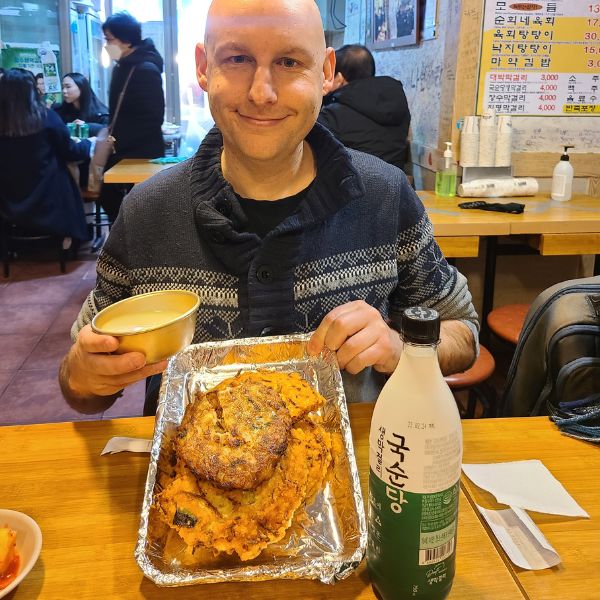
For a more filling meal at a traditional market, check out these 10 mouth watering and stomach filling traditional Korean dishes. Again, to find out more about these dishes, be sure to read my article about the best Korean traditional dishes you must try in Korea:
- Kalguksu (handmade knife-cut noodle soup)
- Bindaetteok (mung bean pancake)
- Sundae guk (blood sausage soup)
- Tteokguk (rice cake soup)
- Kimchi jjigae (kimchi stew)
- Seolleongtang (ox bone soup)
- Bibimbap (rice bowl with assorted vegetables and meat)
- Maeuntang (spicy fish stew)
- Bibim dangmyeon (spicy glass noodles with vegetables)
- Yubu jeongol (fried tofu stew)
My tip – don’t be put off by the appearance of Korean food. It might look strange to you, but hiding underneath an unusual exterior, there’s a whole world of new tastes waiting for you to discover. And if something is red, watch out as it’s probably spicy!
How To Pay In Korea’s Traditional Markets
Korea strongly favours credit and debit cards to make payments, as well as mobile payments and bank transfers. Cash isn’t as commonly used these days, but one place you will most likely spend cash in Korea is in a traditional market or street market in Seoul. However, there are recent changes that encourage market vendors to accept cards in Seoul’s market, including 300 stalls in Myeongdong.
The easiest way to pay for goods in Korea’s markets is with cash. Korean money (Korean won) can be confusing as the numbers are very large compared to currencies such as the USD, SGD, or EUR. A street food snack might cost around 3,000 to 5,000 Korean won and a meal anywhere from 10,000 won and up. If in doubt, search for the exchange rate on Google to see how much things cost.
Learn more about how to pay for goods and services while you’re travelling in Korea with my essential guide to paying in Korea, which covers what cards are accepted and where, if you need cash, how to pay for public transport, and lots more. You’ll also find lots of money saving tips for visiting Korea.
Liked This? Pin It For Others
If you enjoyed reading this article, then please share this with your friends on Pinterest.
